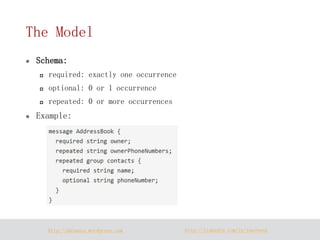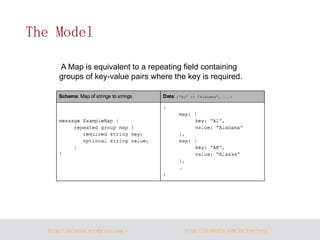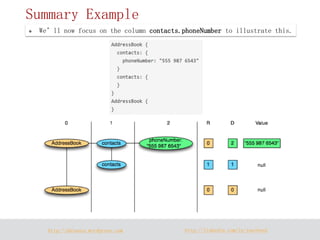Inside Parquet Format
- 1. Parquet-format Yue Chen http://linkedin.com/in/yuechen2 http://dataera.wordpress.com
- 2. http://dataera.wordpress.com http://linkedin.com/in/yuechen2 Goal To have a state-of-the-art columnar storage available across the Hadoop platform Hadoop is very reliable for big long running queries but also IO heavy. Incrementally take advantage of column based storage in existing framework. Not tied to any framework in particular Can be used to store nested data
- 3. http://dataera.wordpress.com http://linkedin.com/in/yuechen2 Columnar Storage Limits IO to data actually needed: loads only the columns that need to be accessed. Saves space: Columnar layout compresses better Type specific encodings. Enables vectorized execution engines.
- 4. http://dataera.wordpress.com http://linkedin.com/in/yuechen2 Columnar Storage row-oriented storage colume-oriented storage
- 5. http://dataera.wordpress.com http://linkedin.com/in/yuechen2 The Model Schema: required: exactly one occurrence optional: 0 or 1 occurrence repeated: 0 or more occurrences Example:
- 6. http://dataera.wordpress.com http://linkedin.com/in/yuechen2 The Model Lists (or Sets) can be represented by a repeating field.
- 7. http://dataera.wordpress.com http://linkedin.com/in/yuechen2 The Model A Map is equivalent to a repeating field containing groups of key-value pairs where the key is required.
- 9. http://dataera.wordpress.com http://linkedin.com/in/yuechen2 How to store? The structure of the record is captured for each value by two integers called repetition level and definition level. Using definition and repetition levels, we can fully reconstruct the nested structures.
- 10. http://dataera.wordpress.com http://linkedin.com/in/yuechen2 Definition Levels To support nested records we need to store the level for which the field is null.
- 11. http://dataera.wordpress.com http://linkedin.com/in/yuechen2 Definition Levels Example
- 12. http://dataera.wordpress.com http://linkedin.com/in/yuechen2 Definition Levels More Example The maximum definition level is now 2 as b does not need one.(cannot be null)
- 13. http://dataera.wordpress.com http://linkedin.com/in/yuechen2 Repetition levels To support repeated fields we need to store when new lists are starting in a column of values. The repetition level can be seen as a marker of when to start a new list and at which level.
- 14. http://dataera.wordpress.com http://linkedin.com/in/yuechen2 Repetition levels Example 0 marks every new record and implies creating a new level1 and level2 list; 1 marks every new level1 list and implies creating a new level2 list as well; 2 marks every new element in a level2 list;
- 15. http://dataera.wordpress.com http://linkedin.com/in/yuechen2 Repetition levels Example
- 17. http://dataera.wordpress.com http://linkedin.com/in/yuechen2 We’ll now focus on the column contacts.phoneNumber to illustrate this. Summary Example
- 18. http://dataera.wordpress.com http://linkedin.com/in/yuechen2 To write the column we iterate through the record data for this column: contacts.phoneNumber: “555 987 6543” new record: R = 0 value is defined: D = maximum (2) contacts.phoneNumber: null repeated contacts: R = 1 only defined up to contacts: D = 1 contacts: null new record: R = 0 only defined up to AddressBook: D = 0 Summary Example
- 19. http://dataera.wordpress.com http://linkedin.com/in/yuechen2 The columns contains the following data: Summary Example
- 20. http://dataera.wordpress.com http://linkedin.com/in/yuechen2 To reconstruct the records from the column, we iterate through the column: R=0, D=2, Value = “555 987 6543”: R = 0 means a new record. We recreate the nested records from the root until the definition level (here 2) D = 2 which is the maximum. The value is defined and is inserted. R=1, D=1: R = 1 means a new entry in the contacts list at level 1. D = 1 means contacts is defined but not phoneNumber, so we just create an empty contacts. R=0, D=0: R = 0 means a new record. we create the nested records from the root until the definition level D = 0 => contacts is actually null, so we only have an empty AddressBook Summary Example
- 21. http://dataera.wordpress.com http://linkedin.com/in/yuechen2 Compression Codecs Snappy, GZIP; currently Snappy by default
- 22. http://dataera.wordpress.com http://linkedin.com/in/yuechen2 Reference https://blog.twitter.com/2013/dremel-made-simple-with- parquet





















